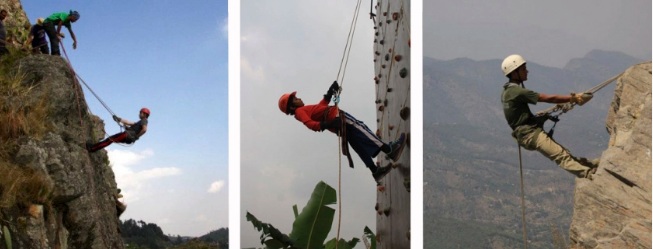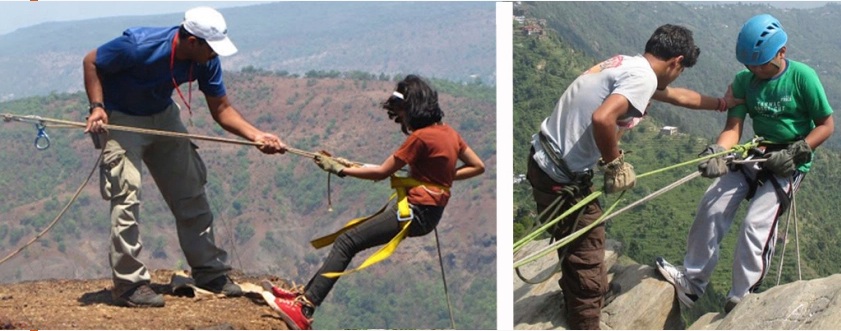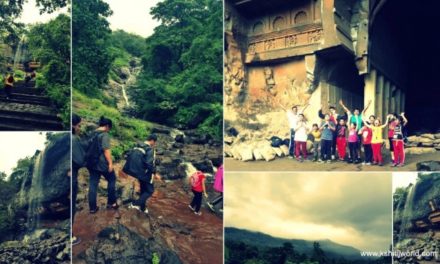It took him plenty of courage in that already fearful state of mind, to cross over and go to the outer side of the rappelling wall. It is at this point that one is supposed to lean behind as an initial step to climbing down the wall. It is at this point that the fear reaches its peak. As one participant child told me, ‘It felt like I would fall down and the back of my head would hit the floor!’ Although all the safety harnesses are used, and the participants are aware of that, fear finds its way. This boy, around eleven years old, already seemed too scared – most participants are, children and adults alike, when they climb those stairs which feel like they are floating in the air, with no walls around them. This, coupled with the widely prevalent fear of heights, makes the activity even more challenging for many, especially the first timers!
The moment he got himself to the outer side of the wall, he almost freezed there. The technical expert tried encouraging him to lean back and start rappelling down, but in vain. Just when I started telling the technical expert to get the boy back inside, I saw tears in his eyes. We got him inside. I told him to sit, breathe and relax; offered him some water. It seemed liked he wanted to be alone for some time. So I started attending to the other participants, while constantly aware of the boy and how he was feeling. After sometime, I sat beside him, and we began conversing.
We were looking at other participants doing the activity while we were talking. Almost everyone had that look of ‘I’m scared but I would like to be able to do it!’ on their face. I made him aware of how the initial part of leaning behind was scary for all of them, after which it got easier. He expressed his concerns and I explained to him how the safety gear that we use keeps us in total control and keeps them completely safe. Not once in the conversation did I ask him, ‘Would you like to try again?’ That didn’t feel right to ask at that moment. In fact, I told him that I’ll take him safely down the stairs if he wishes to do so. I reminded him that we had already decided earlier as a group that we would be following the principle of ‘Challenge by choice’* and no one would force him to complete the activity. I was quite surprised by the way I was dealing with the situation. It almost felt to me like I was being his ‘mum’ at that time, who was trying to make him feel safe and was trying to do the right thing for him at that moment.
A few minutes passed by while the other participants continued doing the activity. And then came that moment of magic! He told me that he wanted to do the activity, this time, with a lot more confidence in his voice. He got up. We helped him put on the safety harness. He crossed over to the outer side of the wall. No wonder he was scared! But this time, he did not freeze. With some encouragement from our side, he leaned behind and went down rappelling on the wall. I saw him from above when he reached the floor. With both his hands up in the air, he felt and expressed a strong sense of victory!
A few minutes later, almost the same story got replayed, with another participant. Only this time, when he finally reached the floor rappelling down the wall, he happened to say, ‘Hey, this was easy!’ – wondering, why was he so scared at all in the first place.

While this was happening, one of the participants, who had mustard enough courage to climb those stairs after some initial hesitation, was standing there on the top for quite some time, looking at other participants doing the activity. She was the only one remaining. I asked her, ‘Would you like to try?’ She said yes. And during that crucial moment when she had to lean back, she got highly scared and changed her mind. I told the technical expert to get her back inside. She almost rushed to go back down the stairs. I told her to wait, breathe and I accompanied her down the stairs. I tried telling her things like ‘It was quite brave of you to climb up those stairs and attempt the activity’. But I knew that nothing I would say would make her feel completely fine about the fact that she didn’t go ahead with it, while most others were able to do so. A few moments ago, when she was up there, on the outer side of the wall, I had a choice. I could force her down the wall (while ensuring her safety) and hope that it would help her overcome her fear and feel good about herself. But that would bring with it the risk of it becoming an experience that she would thereon associate with a state of ‘panic’, and may be, never ever attempt it at all. And this would not only defeat the entire purpose of the activity, but could also cause damage to her overall self-confidence.
The activity was over. I walked away from the wall with a lot of thoughts in my mind, but with an overall positive feeling in me, a feeling for which I haven’t yet found the exact word. A feeling that I would like to further explore in the years ahead. A feeling that may be the prime reason behind my current desire to be a part of more such experiences as a facilitator. A feeling that comes back to me every time I think of those moments – those ‘Lil’ moments of meaningfulness in which the power of ‘Challenge by choice’ came alive!
Nikhill (raahi)
* This experience was a part of the three-day camp for a school organized by ‘Kshitij – Redefining Fun’. At Kshitij, we try and add value to the lives of participants by using a methodology called ‘Experiential Education’. One of the key principles we follow is ‘Challenge by Choice’, wherein the participants themselves choose the way they want to participate in a particular activity and the level of challenge they would like to attempt. It has been observed that learning that happens in this way is more effective and ownable than in a situation where the participants are reluctantly made to do an activity on someone else’s terms.



